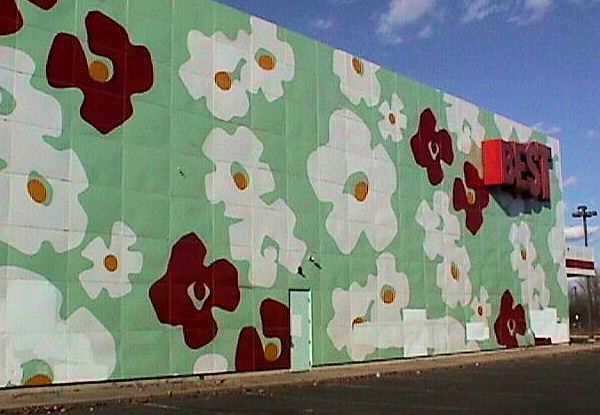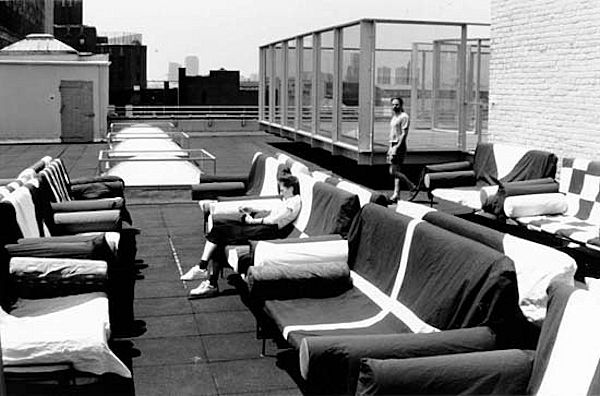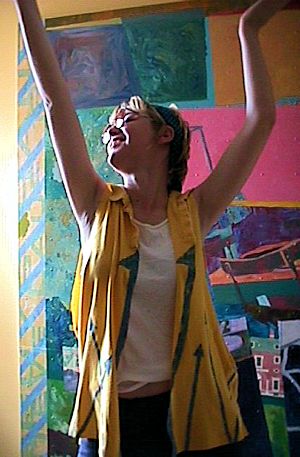2002.04.03 11:31
Re: [art] being/appositional [to architecture]
Probably my favorite "Venturi appliqué" is the (now derelict) Best Showroom.

By the way, Steve Izenour once said, "I happen to think the only way you preserve a place like this [i.e., Wildwood, New Jersey], or like Las Vegas, is through photographs."
2002.04.03 11:35
apposition beach, apposition eye
In Webster's Third New International Dictionary (1969) you will find the following definitions:
apposition beach : one of a series of beaches successively formed on the seaward side of an older beach
apposition eye : a compound eye that is characteristic of diurnal insects and in which entering light reaches the retina of each ommatidium as a single spot and the image is a composite of all the spots
2002.04.03 18:38
Re: [art] ? [architecture]
Back in the early 1990s, when the only 'architecture' I was doing was to build 3d cad models on a computer screen, I was also devoting a lot of my time to painting (yet, even my paintings started as cad data files--I composed or traced image linework using a digitizing tablet, plotted out the image as enlarged segments on either mylar or canvas paper, then attached the pieces to large 7.5'x4' framed homasote supports, and then painted away). I might be the only person alive to have used architecture cad software and hardware in this way.
In just doing a websearch of Warhol's Last Supper (appositional) paintings, I was quickly reminded of what I and Ron Evitts were doing on Saturday, 29 September 1994.
Hey Ron, remember all the different (art and architecture) things we talked about on DIA's roof while lounging in West's Rest?

Franz West, Rest (New York: installation on the roof of the Dia Center, September-October 1994 and April-June 1995).
| |
2002.04.04 10:49
Re: [art] being/appositional [architecture]
In general, appositional here refers to the notion of:
applying (one thing) to another
and
deposition of successive layers upon those already present (as in cell walls)
Beyond that, the questions I raised here yesterday involve the notion that architecture (over the ages) has largely been apposed with other art forms or with other engineering forms. I thought it would be interesting to openly discuss what those 'other' yet directly near applications are or are not, and how the appositions change or don't change the 'original' layer. For that matter, identifying what the original layer is may also evoke interesting positives and negatives.
Of course, opposition to any of the above 'appositional' ideas is apposite as well.
2002.04.04 16:48
re: [art] being/appositional [to architecture]
Do you think there might also be such things (in design) as "difficult appositions"?
If so, any "good" examples? And/or is coming to grips with "difficult appositions" something designers should be aware of or be willing and/or able to deal with?
2002.04.06 10:19
being/critical
Brad, I have some questions regarding the statement that you've come to realize that "it's virtually impossible (on a few levels) to make viable art that claims to 'address a critical dialogue...""
If art that claims to address a critical dialogue does not exist, what made you think that it did or could exist?
Could it be that viable art is really a critical monologue?
aside: at the end of my (first or only?) 'fashion designer' phase (1984-85), I created a nice sleeveless shirt (an apposed Calvin Klein--all my fashions were generated via applied layers (of MAB interior house paint) and/or new cuttings applied to newly bought existing fashion items). On the front was painted "IT'S KISSIN' ME" with an arrow below these words pointing down at the crotch area, and on the back was painted "IT'S KISSING ME" with an arrow below these words pointing down to the buttocks area. When worn on a night out, this garment engendered much critical dialogue. Optional accessories: authentic 1963 Mercedes-Benz hood ornament on a long key chain; aviator style mirrored sunglasses. (note: the first time I saw Black rappers wearing Mercedes-Benz hood ornaments was circa 1986.)
Critical is as critical does?
Anna, my assistant this past summer, was quite surprised when I asked her to model my fashions so I could photograph them, but I must say she did it in style. For example, when I asked her to pose while figuratively reenacting The Rape of the Sabine Women by Poussin, she immediately knew what to do.
Dutch architects Ben van Berkel and Caroline Bos in their 1999 book MOVE wrote: "The architect is going to be the fashion designer of the future." Wonder why it took them so long to come to that hypothesis.
Steve

Stephen Lauf, IT'S KISSIN' ME Shirt (house paint on Calvin Klein polo shirt, 1985).

Stephen Lauf
Polo Shirt with Spears
house paint on Ralph Lauren polo shirt
1984-5
|

Nicolas Poussin
detail of The Rape of the Sabine Women
1634-35
|
| |
2002.04.07 16:43
Re: art as architecture as art
Stephen Lauf
and
The Unfinished Style
Do you think that's an appropriate title for a documentation of me and my art and my architecture? It certainly describes most of what I do (or rather what I don't do). Look, a virtual first sentence: "I am, therefore, I am unfinished." With a title and concept like that, I can accomplish just about anything as long as I don't finish it. Could it be that I now know what I'm best at?
2002.04.08 14:06
Re: art as architecture as design
But John, I don't yearn for the term 'great' to be applied to my work. If any of my work is great it is because of what the work itself is, not whether or not some others apply greatness to the work.
My artwork is for the most part unknown. Besides myself, only Anna DiCicco, Tony D'Aulerio, and Ron Evitts know a fair amount of my art work, but even they do not know the full extent of it, yet I doubt any of these individuals would say that I have doubts about my artwork. They themselves may have doubts about my work, but I don't think they would honestly say that I have doubts about my work.
It might well be great for more people to know my work, or it might not be. In either case, I can display my work at www.museumpeace.com anytime I want, and that suits me just fine--it's actually a great place for my artwork.
2002.04.08 16:11
[give it a] REST
"I want the artwork to be real, not like a dream or a movie," Franz West recently stated: "...[I want] to be able to step into it, to sit on it, lie on it...The artist lives in a social environment, he doesn't just produce work from the other side," West avers, continuing, "... this is the art of today, lying down on the bed looking up into space. It doesn't matter what the art looks like but how it's used. The important thing is to find a place for art, not a description."
Lynne Cooke, "Franz West: Rest"
2002.04.09 16:08
"Can Art Be Taught"
...The virtual takeover of art teaching by the universities in this country has coincided with the dying out of teaching methods passed down from the medieval guilds to the apprenticeship system of the Renaissance and, after, to the nineteenth-century beaux-arts academies in Europe, and this has had a profound effect on the kind of art that gets produced.
"Can there be any doubt that training in the university has contributed to the cool, impersonal wave in art of the sixties?" the critic Harold Rosenberg observed in 1970. In order to become an academic discipline, art had to be intellectualized. Craft and technique were subordinated to verbal analysis, problem solving, and critical theory. University-based art teaching, in fact, became more and more like scientific research, with the pursuit of ideas as its primary goal.
Calvin Tomkins, "Can Art Be Taught?" in The New Yorker (2002.04.15).
2002.04.10 14:15
Re: being/critical
Does a critical dialogue also not exist among the "far-flung "constellation" of kindred spirits"?
You do read the Benz ornament with the correct "funniness". The first time I actually saw the very same "Silver Star" was in Summer 1963, just after being on a taxi ride through part of Luxembourg and into West Germany, after having had (fish) dinner in Iceland the night before. The car was ordered and purchased by my father at Keenan Motors on Broad Street in Philadelphia, and then was waiting for our family of four as we embarked on a five week car trip through West Germany and Austria. I was seven years old at the time, Otto was ten. The two of us had a great time. We swam and played miniature golf constantly--for two weeks we played m-golf high above the Elbe River, in full view of the actual Iron Curtain.
The fashions are among the earliest manifestations of the same 'spirit' that later manifested Museumpeace (the chair).
|